Statistics Publication Notice: Early Destinations of Students Qualifying from Scottish Higher Education Institutions 2011-12
Statistics on the first destinations of leavers from Scottish Higher Education Institutions (HEIs), 6 months after qualifying.
Analysis
The information presented in this publication relates to the initial destinations (six months after qualifying) of students gaining higher education (HE) qualifications from Scottish Higher Education Institutions (HEIs) - such students will be referred to as leavers in the remainder of this release.
Destinations of leavers from Scottish HEIs
Employment within the UK was the most common destination for leavers (65.0 per cent). The second most common destination was further study or training (19.0 per cent). The percentage of leavers believed to be unemployed was 6.2 per cent, whilst 5.4 per cent were working overseas (Table 1, Figure 2).
In total, 89.3 per cent of leavers from Scottish HEIs were in further study, training or employment.
Figure 2: Destination of leavers from Scottish HEIs, 2011-12
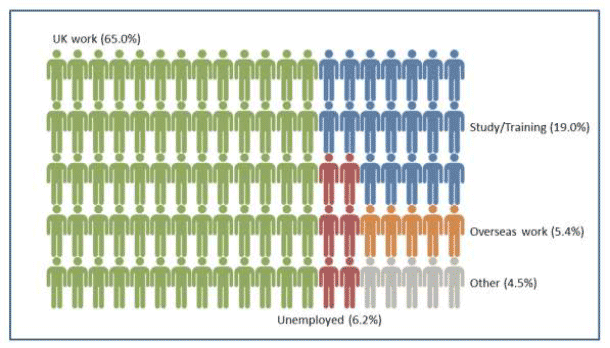
Source: Higher Education Statistics Agency (HESA)
Reference: Table 1
Destinations by level of qualification
Looking at leaver destinations by level of qualification obtained we see that the higher the level of qualification obtained, the higher the percentage of leavers in employment (UK and overseas) and the lower the percentage of leavers in further study (Table 1, Figure 2).
However, we should note that the higher employment percentage for postgraduate leavers is not necessarily a direct result of their higher qualifications. The activities of leavers prior to, or during, study also have an impact on their employment prospects.
For example, postgraduate qualifications may be undertaken by those already in employment (perhaps to formalise their experience or to meet requirements of their employers). It could therefore be expected that a higher percentage of postgraduate leavers will enter (or return to) employment post-study.
It might also be expected that those with lower levels of qualifications are the most likely to go on to further study or training as they are likely to be at an earlier stage in their education. There are also fewer options for higher levels of study for those qualifying at postgraduate level.
Figure 3: Destination of leavers from Scottish HEIs by qualification obtained, 2011-12
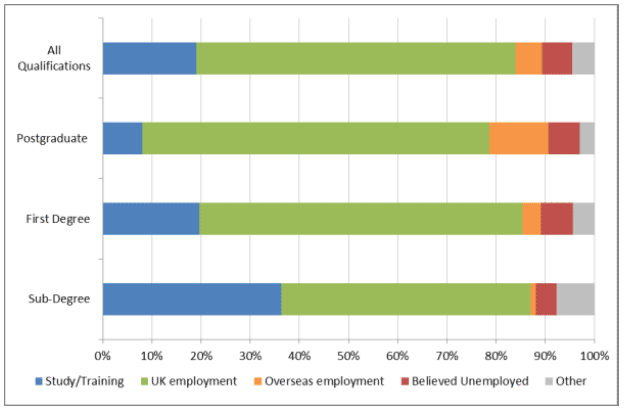
Source: Higher Education Statistics Agency (HESA)
Reference: Table 1
Destinations by gender
The pattern of destinations is broadly similar for male and female leavers. However, a slightly higher percentage of males were engaged in further study/training, overseas employment and unemployment, while a higher percentage of females were in UK employment (Table 1, Figure 4).
Figure 4: Destination of leavers from Scottish HEIs by qualification obtained and gender, 2011-12
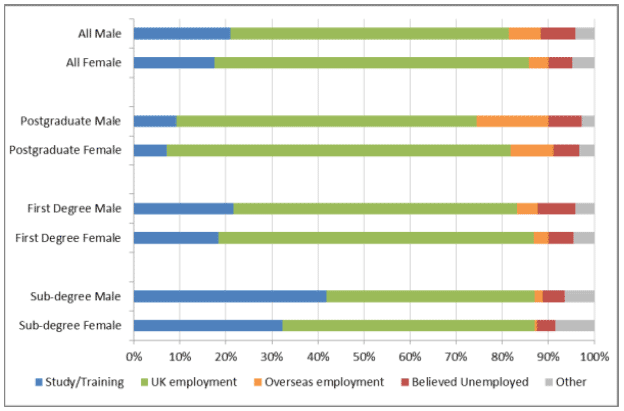
Source: Higher Education Statistics Agency (HESA)
Reference: Table 1
Where there are differences between the genders, it is important to note that gender may not be the direct cause. Another factor to consider is subject studied. For example, a relatively low percentage of leavers who studied Engineering and Technology, traditionally a male dominated subject, went into UK employment (58.9 per cent); whilst a relatively high percentage of leavers who studied Education, traditionally female dominated subject, were in UK employment (93.2 per cent) (Table 2).
Destinations by subject
Those leaving Scottish HEIs with a Law qualification were the most likely to be undertaking further study or training activities (35.9 per cent), followed by leavers with a Physical Science qualification (32.8 per cent).
Leavers who obtained an Education qualification were the most likely to be in UK employment (93.2 per cent), followed by those with a Medicine and Dentistry qualification (86.2 per cent).
Leavers who obtained an Information Technology qualification were the most likely to be unemployed (10.7 per cent), followed by those with a Creative Arts qualification (10.4 per cent) (Table 2).
Figure 5: Destination of leavers from Scottish HEIs by subject area, 2011-12
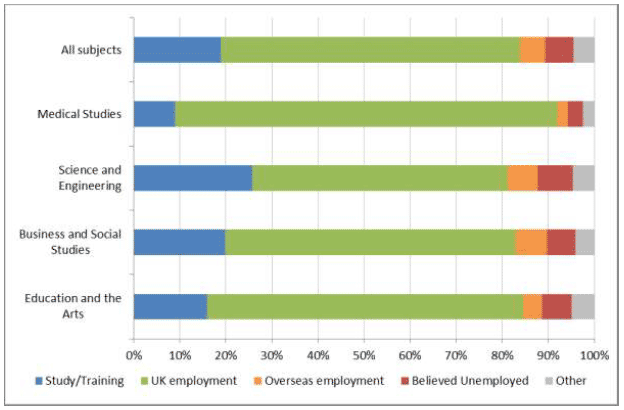
Source: Higher Education Statistics Agency (HESA)
Reference: Table 2
Leavers from Scottish HEIs in Employment
Employment basis of leavers in employment
The majority of leavers in UK employment were employed on permanent contracts (56.0 per cent) with a further 21.7 per cent employed on fixed term contracts lasting 12 months or longer. Around one in ten leavers who found UK employment were working on a more temporary basis, with 8.8 per cent employed on fixed term contracts lasting less than 12 months and a further 2.1 per cent temping. (Table 3, Figure 6).
Figure 6: Employment basis of leavers from Scottish HEIs: 2011-12
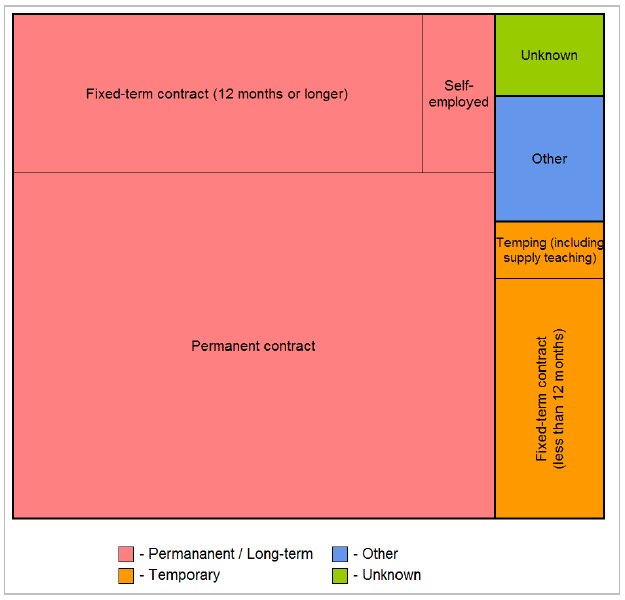
Source: Higher Education Statistics Agency (HESA)
Reference: Table 3
Looking at employment basis by level of qualification obtained we see that the lower the level of qualification obtained, the higher the percentage of leavers employed on permanent contracts (Table 3).
Occupation of leavers in employment
The occupations of leavers can be grouped using the Standard Occupational Classification (SOC). The SOC contains eight major groups with the first three groups (SOC 1 to 3) covering Managerial and Professional occupations. In 2011-12, around three quarters of leavers (75.1 per cent) who found UK employment were employed in Managerial and Professional occupations (Table 4, Figure 7).
Figure 7: Occupation of leavers from Scottish HEIs: 2011-12

Source: Higher Education Statistics Agency (HESA)
Reference: Table 4
Looking at occupation by level of qualification obtained we see that the higher the level of qualification obtained, the higher the percentage of leavers in Managerial and Professional occupations (SOC 1 to 3) (Table 4).
Location of leavers in employment
By comparing leavers' pre-study domicile with their location of employment we can get an early indication of the flows of leavers from Scottish HEIs to other parts of the UK and overseas. The vast majority of Scottish domiciled leavers who found employment did so in Scotland (89.1 per cent). This compares with around a third (33.0 per cent) of leavers domiciled in other parts of the UK. Similarly, around a third (33.5 per cent) of other EU domiciled leavers who found employment did so in Scotland (Table 7, Figure 8).
Figure 8: Employment location of leavers from Scottish HEIs by pre-study domicile: 2011-12
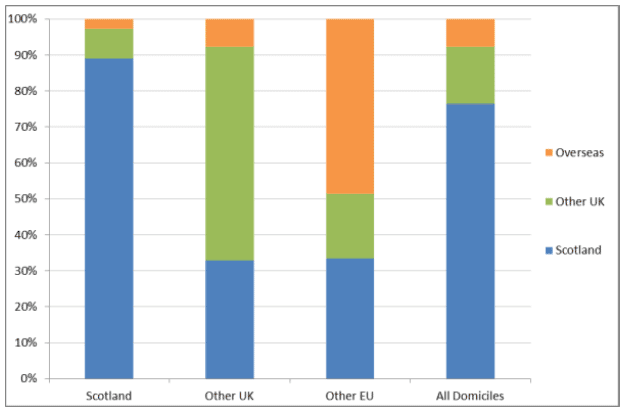
Source: Higher Education Statistics Agency (HESA)
Reference: Table 7
Time Series Analysis
In 2011-12 HESA re-designed the DLHE survey to collect richer information from leavers particularly regarding their activities on the survey date. Further details are provided in section 2.1 of the Methodological Notes.
These changes limit the comparability of the 2011-12 results with previous years.
Figure 9: Percentage of leavers from Scottish HEIs in employment or further study/training: 2007-08 to 2010-11, 2011-12
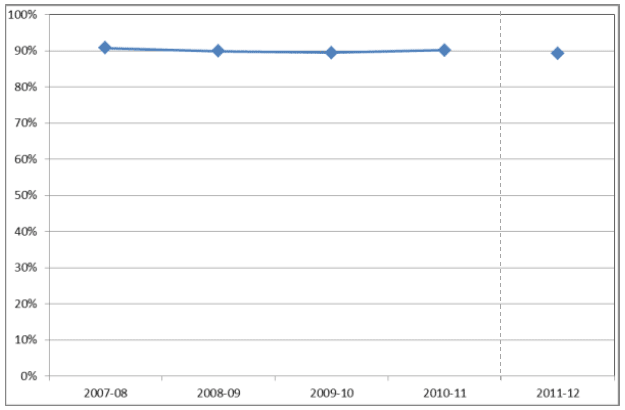
NOTE: The comparability of the time series is limited by changes implemented in the 2011-12 DLHE survey. Further details are provided in the Methodological Notes (2.1).
Source: Higher Education Statistics Agency (HESA)
Reference: Table 1 and Table 12
Contact
Email: Post-16 Education Statistics
There is a problem
Thanks for your feedback